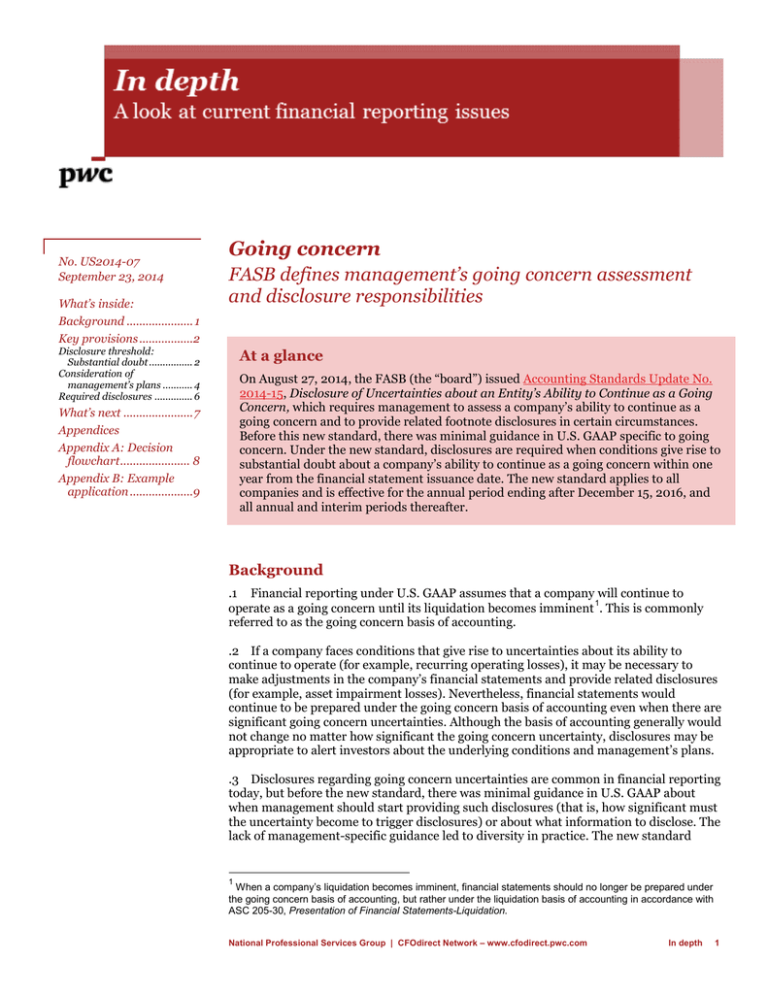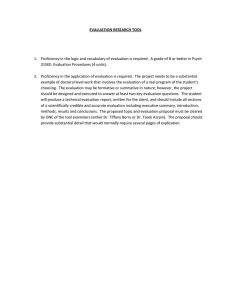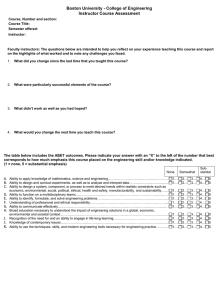
No. US2014-07
September 23, 2014
What’s inside:
Background ..................... 1
Key provisions .................2
Going concern
FASB defines management’s going concern assessment
and disclosure responsibilities
Disclosure threshold:
Substantial doubt ................ 2
Consideration of
management’s plans ........... 4
Required disclosures .............. 6
At a glance
On August 27, 2014, the FASB (the “board”) issued Accounting Standards Update No.
2014-15, Disclosure of Uncertainties about an Entity’s Ability to Continue as a Going
Concern, which requires management to assess a company’s ability to continue as a
going concern and to provide related footnote disclosures in certain circumstances.
Before this new standard, there was minimal guidance in U.S. GAAP specific to going
concern. Under the new standard, disclosures are required when conditions give rise to
substantial doubt about a company’s ability to continue as a going concern within one
year from the financial statement issuance date. The new standard applies to all
companies and is effective for the annual period ending after December 15, 2016, and
all annual and interim periods thereafter.
What’s next ...................... 7
Appendices
Appendix A: Decision
flowchart ...................... 8
Appendix B: Example
application ....................9
Background
.1 Financial reporting under U.S. GAAP assumes that a company will continue to
1
operate as a going concern until its liquidation becomes imminent . This is commonly
referred to as the going concern basis of accounting.
.2 If a company faces conditions that give rise to uncertainties about its ability to
continue to operate (for example, recurring operating losses), it may be necessary to
make adjustments in the company’s financial statements and provide related disclosures
(for example, asset impairment losses). Nevertheless, financial statements would
continue to be prepared under the going concern basis of accounting even when there are
significant going concern uncertainties. Although the basis of accounting generally would
not change no matter how significant the going concern uncertainty, disclosures may be
appropriate to alert investors about the underlying conditions and management’s plans.
.3 Disclosures regarding going concern uncertainties are common in financial reporting
today, but before the new standard, there was minimal guidance in U.S. GAAP about
when management should start providing such disclosures (that is, how significant must
the uncertainty become to trigger disclosures) or about what information to disclose. The
lack of management-specific guidance led to diversity in practice. The new standard
1
When a company’s liquidation becomes imminent, financial statements should no longer be prepared under
the going concern basis of accounting, but rather under the liquidation basis of accounting in accordance with
ASC 205-30, Presentation of Financial Statements-Liquidation.
National Professional Services Group | CFOdirect Network – www.cfodirect.pwc.com
In depth
1
provides management with direct guidance on going concern assessments and
disclosures.
.4 Presently, U.S. auditing standards and federal securities law require auditors to
evaluate a company’s ability to continue as a going concern, and auditing standards
require auditors to consider management’s footnote disclosures.
.5 The new standard incorporates some of the principles of the current auditing
standards and builds upon them, as follows:
•
Requires an assessment each annual and interim reporting period.
Audits are generally conducted annually; thus, auditing standards do not apply to
interim periods.
•
Defines substantial doubt. Auditing standards do not explicitly define
substantial doubt.
•
Sets a look-forward period of one year from the financial statement
issuance date. Auditing standards provide a shorter look-forward period of one
year from the balance sheet date.
•
Requires disclosures even when an initially-identified substantial doubt
is alleviated by management’s plans. The auditing standards indicate that
auditors should consider the adequacy of disclosures in these situations, but there
are no specific disclosure requirements.
Key provisions
Disclosure threshold: Substantial doubt
.6 Under the new standard, the emergence of substantial doubt about a company’s
ability to continue as a going concern is the trigger for providing footnote disclosure. For
each annual and interim reporting period, management should evaluate whether there
are conditions that give rise to substantial doubt within one year from the financial
statement issuance date, and if so, provide related disclosures. The board adopted the
auditing standard’s substantial-doubt concept and defined it in the new standard to
reduce the diversity in its interpretation under current practice.
.7 The assessment is required to be performed for each reporting period including
interim periods. Accordingly, SEC registrants with interim reporting requirements
should assess going concern uncertainties quarterly. Nonpublic entities should assess
going concern uncertainties annually, or more frequently if they issue interim financial
statements that are prepared under U.S. GAAP.
PwC observation:
Companies will need to implement processes and controls (or formalize existing
ones) to assess risk, to determine the level of analysis necessary, and to perform the
going concern assessment. Companies may be able to leverage their existing
processes and controls that are used in assessing risks and developing forecasts.
.8 The new standard indicates that conditions that give rise to substantial doubt
ordinarily relate to a company’s ability to meet its obligations as they become due. It also
provides a definition of substantial doubt that is principally based on likelihood.
Substantial doubt exists when conditions and events, considered in the aggregate,
indicate it is probable that a company will be unable to meet its obligations as they
National Professional Services Group | CFOdirect Network – www.cfodirect.pwc.com
In depth
2
2
become due within one year after the financial statement issuance date . The likelihood
threshold of probable is defined as “the future event or events are likely to occur,” which
is consistent with its current use in U.S. GAAP applicable to loss contingencies.
PwC observation:
During its deliberations, the FASB made it clear that “probable” represents a higher
likelihood threshold than its initially-proposed “more-likely-than-not” threshold.
Discussions at public meetings of the FASB attributed a likelihood range of
approximately 70 to 80 percent when describing how practice in the U.S. generally
interprets “probable” with respect to loss contingencies. However, the assessment is
not intended to rely on a formula-based likelihood calculation. Management will have
to consider all relevant qualitative and quantitative information and exercise
judgment.
.9 Management’s assessment should be based on the relevant conditions that are
“known and reasonably knowable” at the issuance date, rather than at the balance sheet
date. This means that the assessment should consider the most current information
available before the financial statements are issued, requiring companies to consider all
relevant subsequent events after the balance sheet date. The term “reasonably knowable”
was introduced to emphasize that a company should make a reasonable effort to identify
conditions that it may not readily know, but that could be identified without undue cost
and effort.
Illustration: Look-forward period
3
The assessment date
The assessment
The look-forward period
Assess conditions
known (or reasonably
knowable) at the FS
issuance date…
...to determine if it is
probable that entity
will not meet
obligations within...
…one year from FS
issuance date.
12/31/X1
3/1/X2
12/31/X2
3/1/X3
Balance
sheet date
Financial statement
issuance date
One year from
the balance
sheet date
One year from
the FS
issuance date
.10 The substantial doubt definition is principally based on likelihood, but the standard
indicates that both quantitative and qualitative information should be considered in the
assessment. Management should consider information about the following conditions,
among others, as of the financial statement issuance date:
2
For companies that are not SEC filers, the assessment period is one year from the date the financial
statements are available to be issued, which is defined in ASC 855, Subsequent Events.
3
Adapted from Appendix A of the FASB’s May 7, 2014 Board Meeting Handout. The FASB material is
copyrighted by the Financial Accounting Foundation, 401 Merritt 7, Norwalk, CT 06856, and is reproduced with
permission.
National Professional Services Group | CFOdirect Network – www.cfodirect.pwc.com
In depth
3
•
The company’s current financial condition including its current liquid
resources (for example, available cash or available access to credit)
•
Conditional and unconditional obligations due or anticipated in the next
year (whether or not they are recognized in the financial statements)
•
Funds necessary to maintain operations considering the company’s current
financial condition, obligations, and other expected cash flows in the next year
•
Other conditions that could adversely affect the company’s ability to meet its
obligations in the next year (when considered in conjunction with the above). For
example:
-
Negative financial trends (e.g., recurring operating losses, working capital
deficiencies, or negative operating cash flows)
-
Other indications of financial difficulties (e.g., default on loans, denial of
supplier credit, a need to restructure debt or seek new debt, noncompliance with
statutory capital requirements, or a need to dispose of substantial assets)
-
Internal matters (e.g., labor difficulties, substantial dependence on the success
of a project, uneconomic long-term commitments, or a need to significantly
revise operations)
-
External matters (e.g., significant litigation, loss of a key customer, franchise,
license, patent or supplier, or an uninsured natural disaster)
.11 The assessment of a company’s ability to meet its obligations is inherently
judgmental. The standard indicates that a company should assess relevant conditions in
the aggregate, and weigh the likelihood and magnitude of their potential impact on the
company’s ability to meet obligations within the assessment period.
PwC observation:
The FASB acknowledged that the level of analysis necessary for management’s
assessment will vary depending on a company’s specific facts and circumstances. We
anticipate that a detailed analysis will generally not be necessary when a company has
a history of profitable operations, positive cash flows, substantial liquidity, and no
other significant adverse conditions exist.
A more robust analysis will occasionally be necessary for companies that are
otherwise financially healthy. This may be the case, for example, because of external
factors (such as an economic recession) or because of known events that may risk a
company’s ability to meet its obligations (such as an upcoming debt maturity that
requires refinancing). In some cases, detailed prospective financial information (for
example, forecasted cash flows or covenant calculations) will have to be prepared to
adequately assess whether a company can meet its obligations within the next year.
Consideration of management’s plans
.12 If conditions give rise to substantial doubt in the initial assessment, the standard
requires management to consider its plans and their mitigating impact. In doing so,
management should assess whether its plans to mitigate the adverse conditions, when
implemented, will alleviate substantial doubt. Whether an initially-identified substantial
doubt is alleviated or not will determine the nature of required disclosures.
National Professional Services Group | CFOdirect Network – www.cfodirect.pwc.com
In depth
4
.13 The new standard sets a high bar for a company to be able to take credit in its
assessment for the mitigating impact of its management’s plans. Management’s plans
should be considered only to the extent that information available as of the issuance date
indicates both of the following:
•
It is probable that the plans will be effectively implemented within the assessment
period
•
It is probable that management’s plans, when implemented, will mitigate the
conditions that give rise to substantial doubt within the assessment period
.14 In assessing effective implementation, management should evaluate the feasibility of
the plans in light of the company’s specific facts and circumstances. Management’s
ability to successfully implement the plans is important in this evaluation. Generally, to
be considered probable of being effectively implemented, the standard indicates that
management (or others with the appropriate authority, such as the board of directors)
must have approved the plan before the issuance date.
.15 Management should further assess its plans (that are probable of effective
implementation) to determine whether it is probable that those plans will mitigate the
conditions that give rise to substantial doubt. In this assessment, management should
consider the expected magnitude and timing of the mitigating effect of its plans (for
example, the amount and timing of cash proceeds from the planned sale of a building) in
relation to the magnitude and timing of the relevant conditions or events that those plans
intend to mitigate (for example, the amount and timing of additional cash necessary to
pay down anticipated obligations).
.16 If management concludes that the initially-identified substantial doubt is alleviated
by its plans, the standard still requires certain disclosures about the underlying
conditions and management’s plans. However, such disclosures would not express that
there is substantial doubt. Only if substantial doubt remains despite management’s plans
does the standard require an express statement that there is substantial doubt about the
company’s ability to continue as a concern.
.17 The standard provides examples of plans that management may implement to
mitigate the conditions that give rise to substantial doubt and identifies the types of
information that management should consider in evaluating their feasibility. The
examples are not intended to be all inclusive.
•
Plans to dispose of an asset or business: consider the restrictions on such
disposal, such as covenants that limit disposal, or encumbrances against the asset.
Also consider marketability of the asset
•
Plans to borrow money or restructure debt: consider the availability and
terms of new or existing debt, existing guarantees, commitments, and
subordination clauses
•
Plans to reduce or delay expenditure: consider the feasibility of plans to
reduce overhead or expenditures, to postpone research or maintenance, or to lease
rather than purchase
•
Plans to increase ownership equity: consider the feasibility of raising
additional capital from affiliates or other investors, or arrangements to reduce
current dividends
National Professional Services Group | CFOdirect Network – www.cfodirect.pwc.com
In depth
5
.18 The standard also clarifies that any mitigating effect resulting from a plan to
liquidate the company (for example, cash infusions through liquidation of a business)
should not be considered in the assessment, even if the liquidation is probable of
occurring.
PwC observation:
Consideration of management’s plans is another area requiring significant judgment.
Generally, management should consider the mitigating effect of its plans that have
already been implemented as of the issuance date (for example, proceeds from debt
refinanced prior to the issuance date, cash savings from successful cost-cutting efforts
that are underway, or revenue expected from a back-log of existing customer orders).
However, management should not consider its plans that have not yet been fully
implemented as of the issuance date (for example, debt that has not yet been
refinanced, cost-cutting efforts that have not been initiated, or marketing efforts that
have not yet resulted in customer orders) unless it is probable those plans will be
successfully implemented, and if implemented, probable that the plans will mitigate
the adverse conditions giving rise to substantial doubt.
Required disclosures
.19 Disclosures are only required if conditions give rise to substantial doubt, whether or
not the substantial doubt is alleviated by management’s plans. No disclosures are
required specific to going concern uncertainties if an assessment of the conditions does
not give rise to substantial doubt.
.20 If substantial doubt is alleviated as a result of the consideration of management’s
plans, a company should disclose information that enables users of financial statements
to understand all of the following (or refer to similar information disclosed elsewhere in
the footnotes):
•
Principal conditions that initially gave rise to substantial doubt
•
Management’s evaluation of the significance of those conditions in relation to the
company’s ability to meet its obligations
•
Management’s plans that alleviated substantial doubt
PwC observation:
The standard specifically allows an entity to refer to information elsewhere in the
footnotes (for example, the debt footnote) when substantial doubt is alleviated by
management’s plans. This may be appropriate, for example, when the only significant
adverse condition is an upcoming debt maturity (within the next year), and while the
company does not have enough cash to pay down the entire debt, it is otherwise
financially healthy; accordingly, management determines that is probable the
company will refinance the debt before its maturity date.
In most other cases, we believe that the disclosures should be in a single location in
the footnotes to provide appropriate background and context about the conditions
present and about management’s plans that alleviated substantial doubt.
National Professional Services Group | CFOdirect Network – www.cfodirect.pwc.com
In depth
6
.21 If substantial doubt is not alleviated after considering management’s plans,
disclosures should enable investors to understand the underlying conditions, and include
the following:
•
A statement indicating that there is substantial doubt about the company’s ability to
continue as a going concern within one year after the issuance date
•
The principal conditions that give rise to substantial doubt
•
Management’s evaluation of the significance of those conditions in relation to the
company’s ability to meet its obligations
•
Management plans that are intended to mitigate the adverse conditions
PwC observation:
Whether or not substantial doubt is alleviated, footnote disclosures should focus on
pertinent information about significant conditions that are specific to going concern
uncertainties, management’s evaluation of those conditions, and management’s
plans. SEC registrants may use MD&A to complement and expand upon footnote
disclosures by providing additional context about the potential causes and effects of
going concern uncertainties.
.22 In subsequent annual and interim periods, a company should continue to provide the
disclosures if conditions continue to give rise to substantial doubt in those periods.
Disclosures should become more extensive as additional information becomes available
about the company’s financial condition and about management’s plans. Companies
should provide appropriate context and continuity in explaining how conditions have
changed between reporting periods. In the period substantial doubt no longer exists
(before or after consideration of management’s plans), the standard indicates that
companies should disclose how the relevant conditions were resolved.
What’s next
.23 The new standard will be effective for all companies in the first annual period ending
after December 15, 2016 (December 31, 2016 for calendar year-end companies). Earlier
application is permitted.
.24 The PCAOB and the AICPA’s Auditing Standards Board both have projects on their
agendas to review and potentially modify existing auditing standards related to going
concern. The PCAOB has indicated in a recent staff audit practice alert that the auditor's
evaluation of whether substantial doubt exists is qualitative, based on the relevant events
and conditions and other considerations set forth in the auditing standards. Accordingly,
a determination that no disclosure is required under the new standard is not conclusive
as to whether an explanatory paragraph is required in the auditor’s report. Before initial
adoption, companies and their auditors should discuss the interaction of the new
accounting standards with the auditing standards.
National Professional Services Group | CFOdirect Network – www.cfodirect.pwc.com
In depth
7
Appendix A: Decision flowchart 4
Start
Are the criteria met for
the liquidation basis of
accounting?
(ASC 205-30)
Yes
Apply the liquidation basis of accounting. (ASC 205-30)
No
Are there conditions
or events, considered in the
aggregate, that raise substantial
doubt about an entity’s ability to continue as
a going concern within one year after the
date the financial statements are
issued (or available to be issued)?
(ASC 205-40-50-01
through 50-5)
No disclosures are required specific to going concern
uncertainties under ASC 205-40. See ASC 275 and ASC 450
for other disclosures about risks, uncertainties, and
contingencies, as applicable.
No
Yes
Consider management’s
plans intended to
mitigate the adverse
conditions or events.
(paragraphs 205-40-50-6
through 50-11)
Is it probable that
management’s plans will be
effectively implemented?
(ASC 205-40-50-7
through 50-8)
Yes
Is it probable that
management’s plans
will mitigate the relevant
conditions or events that
raise substantial doubt?
(ASC 205-40-50-10)
An entity shall disclose information to help users understand
the following when substantial doubt is alleviated by
management’s plans:
Yes
1. Principal conditions or events that raised substantial
doubt, before consideration of management’s plans
2. Management’s evaluation of the significance of those
conditions or events
3. Management’s plans that alleviated substantial doubt.
(ASC 205-40-50-12)
No
No
An entity shall disclose information to help users understand the following when substantial doubt is not
alleviated:
1. Principal conditions or events that raise substantial doubt
2. Management’s evaluation of the significance of those conditions or events
3. Management’s plans that are intended to mitigate the conditions or events that raise substantial doubt.
The entity also should include in the footnotes a statement indicating that there is substantial doubt about the
entity’s ability to continue as a going concern within one year after the date that the financial statements are
issued (or available to be issued).
(ASC 205-40-50-13)
4
Reproduced from ASC 205-40-55-1. The FASB material is copyrighted by the Financial Accounting Foundation, 401 Merritt 7, Norwalk, CT 06856, and is reproduced
with permission.
National Professional Services Group | CFOdirect Network – www.cfodirect.pwc.com
In depth
8
Appendix B: Example application
Relevant conditions
Negative financial trends
No significant debt
coming due within the
assessment period
Substantial liquid
resources (cash & line of
credit)
Negative financial trends
No significant debt
coming due within the
assessment period
Limited liquid resources
(cash & line of credit)
Management’s
assessment
results
Is substantial
doubt
alleviated by
management’s
plans?
Management's
plans to mitigate
adverse conditions
Do conditions
raise substantial
doubt?
Cash flow
forecasts
demonstrate the
company will
meet its
obligations within
the assessment
period
Cost cutting
measures
No, because it is
not probable that
the entity will be
unable to meet
obligations within
the next year
N/A
No disclosures
specific to
going concern
required
Cash flow
forecasts
demonstrate the
company will run
out of cash (and
available line of
credit) within the
assessment
period
Sell Division A –
Plan approved by
the board before the
issuance date and it
is probable within
the assessment
period that the plan:
Yes, because it is
probable that the
entity will not
meet obligations
within the next
year – unless it
sells Division A
Yes
Disclose
conditions,
management’s
evaluation, and
management’s
plans that
alleviated
substantial
doubt
Yes, because it is
probable that the
entity will not
meet its
obligations within
the next year –
unless it
refinances
Yes
Limited
incremental
disclosures:
refer to debt
footnote,
mention the
plan to
refinance
Yes, because it is
probable that the
entity will not
meet its
obligations within
the next year –
unless it
refinances
No
Express that
there is
substantial
doubt. Also
disclose
conditions,
management’s
evaluation, and
management’s
plans.
- will be effectively
implemented, and
Disclosures
- will mitigate the
conditions (that is,
sufficient cash will
be generated from
the transaction)
Positive financial trends
and positive working
capital
Significant debt is coming
due within the next year
The company does not
have the ability to repay
all debt at maturity
The company has a
history of refinancing debt
and nothing indicates it
cannot refinance again
Negative financial trends
and limited liquidity
Significant debt is coming
due within the next year
The company does not
have the ability to repay
all debt at maturity
The company does not
have a history of
refinancing debt
Absent a
refinancing, the
company would
not be able to
meet its
obligations within
the next year
Refinance debt
The plan is deemed
to be probable of
being implemented
and probable of
mitigating adverse
conditions
With refinancing,
it would meet its
obligations
Absent a
refinancing, the
company will not
meet its
obligations within
the next year
With refinancing,
it would meet its
obligations
Refinance debt
Plan is not probable
of being
implemented due to
negative financial
trends and lack of
refinancing history
National Professional Services Group | CFOdirect Network – www.cfodirect.pwc.com
In depth
9
Questions?
Authored by:
PwC clients who have questions about this
In depth should contact their engagement
partner. Engagement teams who have
questions should contact the Risk
Management team in the National
Professional Services Group.
Daghan Or
Partner
Phone: 1-973-236-4966
Email: daghan.or@us.pwc.com
Toni Lockett
Senior Manager
Phone: 1-973-236-5483
Email: antonette.l.lockett@us.pwc.com
Guy Raymaker
Partner
Phone: 1-973-236-4180
Email: guy.raymaker@us.pwc.com
© 2014 PricewaterhouseCoopers LLP, a Delaware limited liability partnership. All rights reserved. PwC refers to the United States member firm, and may sometimes refer to the
PwC network. Each member firm is a separate legal entity. Please see www.pwc.com/structure for further details. This content is for general information purposes only, and should
not be used as a substitute for consultation with professional advisors. To access additional content on financial reporting issues, visit www.cfodirect.pwc.com, PwC’s online
resource for financial executives.



